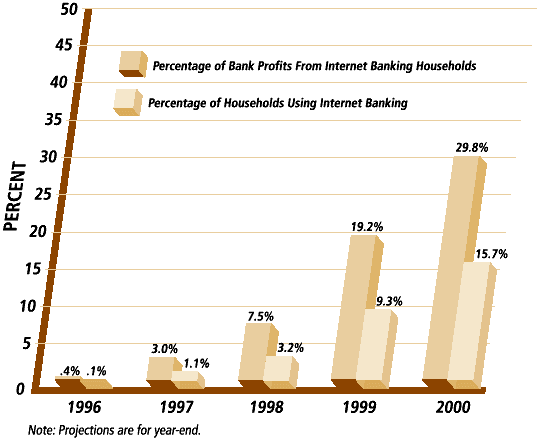The Internet and Retail Banking
Second in a series.
When oil was discovered in the hills of western Pennsylvania more than a century ago, thousands of prospectors poured into the region, built rigs and started drilling. Then they waited for the gushers of "black gold" to come rolling in.
In that same frenzied spirit, banks around the world are rushing these days to set up Internet sites. By the beginning of 1996, such sites had been built by 285 banks in the United States alone. By late spring, that number had risen to 377, with no sign of letting up.
Early in 1996, Booz-Allen & Hamilton's financial services group began an investigation of the "Internet Bank Rush" by conducting a survey of banks that had opened Internet sites. The survey produced a projection that more than 1,500 banks would develop sites within three years. (See "The Internet's Impact on Retail Banking," in Issue 4 of Strategy & Business.)
Consumer Demand
It was this projection that led to Booz-Allen's second Internet banking study, completed in late summer 1996, which looked at the other side of the equation: "Are consumers actually going to use Internet banking?" "What will these consumers look like?" and "How will their use of Internet banking affect the industry?"
The study found -- not surprisingly -- that consumer demand for Internet banking would depend upon the growth of Internet access and on how many consumers were predisposed to using "electronic banking" in the first place. And on both fronts, the study concluded, the numbers were encouraging for the industry.
Access to Internet banking is set to increase at a fantastic rate, according to a number of sources. Increasing personal computer ownership rates, as well as the rapid adoption of the Internet by business, are expected by many to push the number of Internet users worldwide to more than 100 million by the end of the decade.
As for consumer predisposition to electronic banking, surveys consistently indicate that between 55 and 65 percent of PC owners have at least a mild interest in using their computers to conduct banking transactions.
Putting these trends together, the study estimated that almost 16 percent of American households would be using some form of Internet banking by the end of the year 2000. (See Exhibit I.)
Exhibit I
Projected Internet Banking Households, 1996-2000

Note: Projections are for year-end.
Source: Booz-Allen & Hamilton
Internet Banking and Customer Profitability
Even more interesting were the study's conclusions about the profitability of Internet banking customers.
These customers will be similar to the early users of personal computers: They will be younger, more educated and have higher incomes than the average consumer, the study found.
From a financial institution's perspective, this group represents an extremely profitable segment of the customer base. Not only do these customers have high incomes and attractive long-term prospects, but they are also at an age when they are heavy users of a financial institution's most profitable products, such as mortgages and auto loans.
In fact, today's on-line banking customer often accounts for three to four times as much profit as the average customer. Even though this difference will decrease as more people turn to Internet banking, five years from now the on-line user should still produce nearly twice as much profit as the typical bank user.
This high profitability means that while users of Internet banking may represent only 16 percent of total customers by the end of 2000, they may well account for almost 30 percent of retail banking profits. (See Exhibit II.)
Exhibit II
Projected Internet Banking Usage and Share of Retail Banking Profits

Source: Booz-Allen & Hamilton
Trouble on the Horizon
But the high profitability of Internet banking customers is likely to prove a mixed blessing for banks because of two other changes coming down the Internet pike: lower switching costs and new competition.
Switching costs are an economist's way of quantifying how difficult it is for consumers to change banks. According to the study, Internet banking promises to reduce those switching costs by almost 80 percent.
These lower costs, in turn, will open the door to a slew of new competitors. For example, much as they have done in the credit card and health care industries, marketers experienced in targeting discrete groups will no doubt home in on the highly profitable Internet banking customers. Using sophisticated marketing techniques, these competitors will attempt to "cherry pick" the banks' customer bases.
Banks that fail to respond quickly will be caught in a classic case of adverse selection similar to what major credit card issuers faced in the early 1990's and the Blue Cross/Blue Shield plans faced in the 80's. As the banks' most profitable customers are "skimmed" by the cherry pickers, the banks' average service costs will increase, making them less competitive.
To make matters more difficult, the Internet is also creating an entirely new species of financial services competitor. Termed "Integrators," these institutions sit between the banks and their customers. There they serve as the customers' financial gatekeeper: creating a consolidated picture of their finances, providing information and advice and suggesting the lowest-cost, highest-value products and services.
One early version of an integrator is Intuit's Quicken Financial Network. In a hint of things to come, the Quicken site already offers a life insurance quote service that lets consumers review educational material and then shop for and purchase insurance policies all over the Internet. In return, Intuit gets a small commission from the insurance carrier that the customer selects.
Extend that same arrangement to, say, certificates of deposit or checking accounts and it is easy to see why these integrators could quickly become powerful as well as controversial players in the banking business.
In the end, the study found that the net effect of Internet banking would be to put a significant number of a financial institution's most profitable customers into a highly competitive arena. Once there, the customers will find that they can not only switch institutions easily, but that they will have hundreds of alluring alternatives to choose from. Not a pretty picture for bank executives and shareholders.
Learning to Succeed in the New Environment
How will financial institutions hold on to their customers in this new environment? The early signs are that two key elements will play a role: customer knowledge and decision-science capabilities.
Almost all financial institutions have customer information, but very few have true customer knowledge. For example, although almost any institution can tell you what products its customers use, very few can reliably tell you how profitable their customers are or what products they are likely to need next.
Customer knowledge in and of itself will not help a financial institution. To be successful, the institution must be able to translate that knowledge into customized product and service offerings that appeal directly to the needs of individual consumers. This is where decision-science tools -- like predictive models, data mining and intelligent agents -- come in. These leading-edge tools will help a financial institution act on customer knowledge and deliver truly personalized services and products.
Ultimately, the idea is to create products and services that are so unique and useful to customers that it once again becomes difficult for them to switch to another institution.
It remains to be seen whether financial institutions can actually accomplish this goal. But one thing is sure: if they don't, they will put some of their most attractive customers at risk.
Conclusions
The early evidence suggests that Internet banking will be much more than just a passing consumer fad. Indeed, Internet banking promises to be one of the most visible elements driving a sea change in the financial services industry, a change that will radically alter the basis of competition.
Financial institutions that embrace this change may lead the industry into the next century. Those that ignore it, do so at their peril. ![]()
Reprint No. 97101


